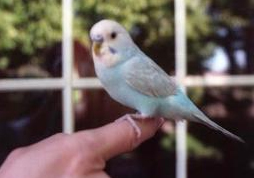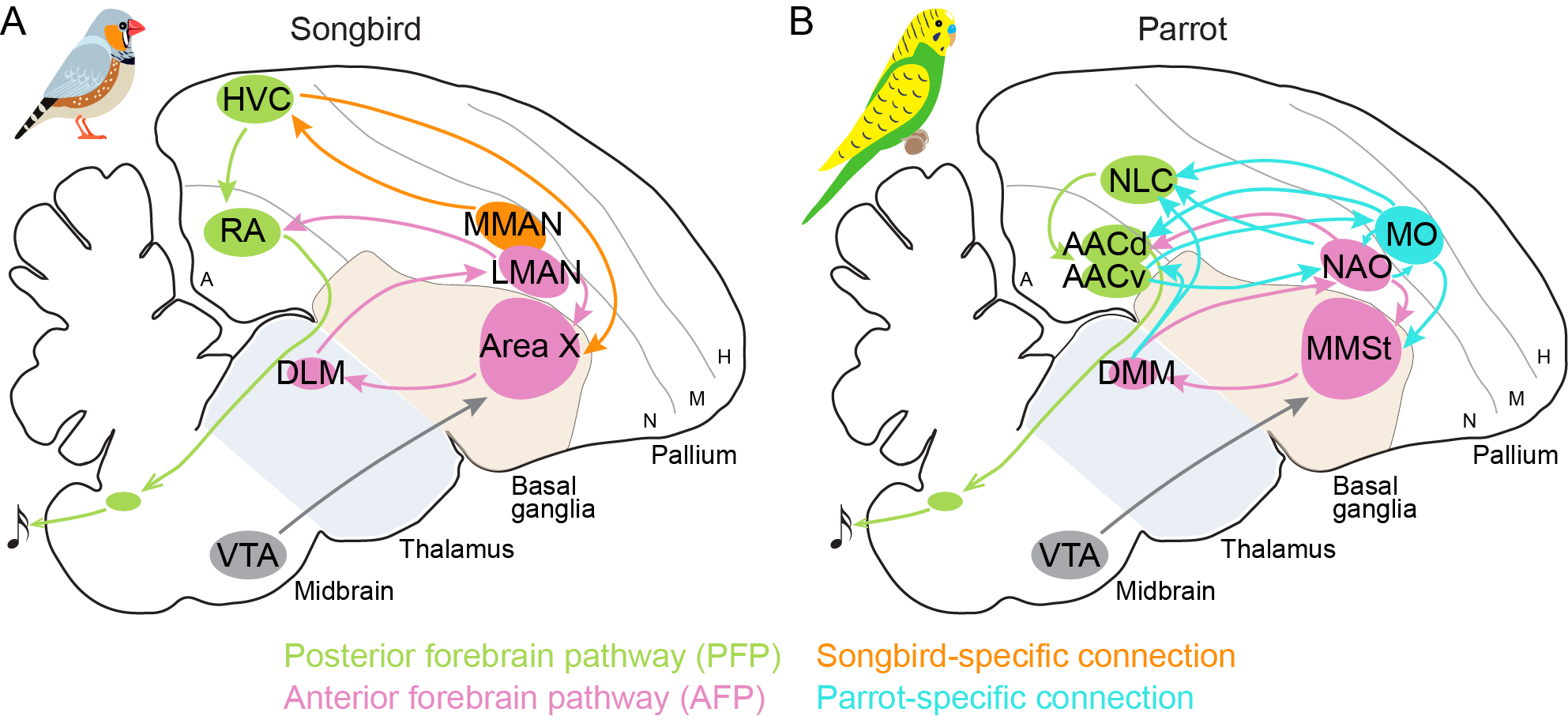After graduate school, I’d like to continue my research on the neural mechanisms of behavioral evolution. However, I also realized that most research on this topic are limited to
innate behaviors and sensory circuits. The evolution of central circuits that control more flexible and learned behaviors remains largely unexplored.
I turned my attention to birds, since their great behavioral diversity is well documentated and certain clades such as parrots and corvids have brain and cognitive capacity that rival those of primates. In 2021, I joined the Comparative Systems Neuroscience Lab at
Cornell University, working with Prof. Jesse Goldberg, a leading expert in avian neurobiology.
Study system: evolution of vocal learning circuits in birds
Human speech is among the most complex and flexible behaviors that have ever evolved on this planet. We can learn to speak virtually unlimited number of words and phrases, and chain them together in creative ways to express our thoughts. However, we know relatively little about how our brains achieve this magic, due to the lack of a proper animal model for mechanistic studies.
In birds, vocal learning is observed in three clades: oscine songbirds, parrots, and hummingbirds. Previous neurobiological studies focused on songbirds, especially zebra finches that learn a courtship song from their tutor during the juvenile stage and produce essentially the same song throughout life. Decades of work has revealed many elegant principles of how this closed-ended mode of vocal learning is implemented in the brain. However, whether these principles can generalize to a more human-like, open-ended mode of vocal learning remains unknown.
In our lab, we began to use budgerigars (Melopsittacus undulatus), a small parrot famous for their  vocal imitation capacities, to address this question. Like humans, budgerigars (budgies) can learn a massive vocal repertoire throughout life. One budgie named Puck (pictured) learned 1728 human words and phrases in less than 5 years and hold the Guiness Record. Another budgie named Disco is on BBC show because of its amazing English pronounication. Given its extraordinary imitation ability and experimental tractablity, we believe that budgerigar is an ideal system to study neural mechanisms of complex vocal learning.
vocal imitation capacities, to address this question. Like humans, budgerigars (budgies) can learn a massive vocal repertoire throughout life. One budgie named Puck (pictured) learned 1728 human words and phrases in less than 5 years and hold the Guiness Record. Another budgie named Disco is on BBC show because of its amazing English pronounication. Given its extraordinary imitation ability and experimental tractablity, we believe that budgerigar is an ideal system to study neural mechanisms of complex vocal learning.
More complex vocal learning circuits in parrots
Interestingly, althrough parrots and songbirds diverged over 50 million years ago, their vocal learning circuits have many anatomical similarities that allows researchers to map analogous structures between the two clades. More specifically, their circuits share a posterior cortico-cortical pathway (PFP) and an anterior forebrain pathway (AFP) comprising a basal ganglia (BG)-thalamocortical loop.
However, there are also important differences: the song system in parrots appear to have more nuclei and recurrent connections. Furthermore, in parrots there are shell structures surrounding most song nuclei, which is not broadly observed in songbirds. How these differences in circuit organization lead to distinct vocal learning capacities is the focus of my postdoctoral work.

Function of forebrain circuits for vocal production
In a recent study, we took a first step by asking whether the pathway-level functions of AFP and PFP are shared between songbirds and parrots. In songbirds, the AFP and PFP have very distinct roles in adult song production. Lesions or inactivations of HVC degrade the acoustic structure of adult song, revealing that the AFP in isolation produces abnormally variable vocalizations even in adults. In contrast, AFP inactivations result in songs with preserved acoustic structure but increased stereotypy, revealing that the PFP in isolation is sufficient for the production of learned and individually unique vocalizations. In short, AFP in songbirds generates variablity for learning, while PFP controls the production of learned stereotyped acoustic structures.
 We examined if AFP and PFP in parrots play similar functions by using reverse microdialysis to transiently inactivate the pathways. Suprisingly, we found that in contrast to songbirds, where the isolated PFP is sufficient to produce stereotyped and acoustically normal vocalizations, isolation of the budgerigar PFP caused a degradation of call acoustic structure, stereotypy, and individual uniqueness. Thus, the contribution of AFP and the capacity of isolated PFP to pro- duce learned vocalizations have diverged substantially between songbirds and parrots, likely driven by their distinct behavioral ecology and neural connectivity.
We examined if AFP and PFP in parrots play similar functions by using reverse microdialysis to transiently inactivate the pathways. Suprisingly, we found that in contrast to songbirds, where the isolated PFP is sufficient to produce stereotyped and acoustically normal vocalizations, isolation of the budgerigar PFP caused a degradation of call acoustic structure, stereotypy, and individual uniqueness. Thus, the contribution of AFP and the capacity of isolated PFP to pro- duce learned vocalizations have diverged substantially between songbirds and parrots, likely driven by their distinct behavioral ecology and neural connectivity.
Ongoing work
In order to understand how neurons in the song nuclei of parrots implement the learning and production of complex vocalizations, we are now recording single unit activities using electrophysiology. Stay tuned to our findings!
